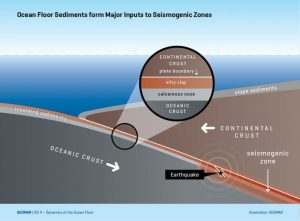
Where a tectonic plate dives under another, in the so-called subduction zones at ocean margins, many strong earthquakes occur. Especially the earthquakes at shallow depths often cause tsunamis. How exactly are such earthquakes initiated? Which rock composition favours a break in the earth’s interior that can lead to such natural disasters? Scientists at GEOMAR Helmholtz Centre for Ocean Research Kiel and the University of Utrecht (NL) published a study in the scientific journal Nature Geoscience which points to earthquake nucleation in calcareous sediments.
The effects of earthquakes are often severe and highly visible. They can destroy homes, induce slope failures and trigger tsunamis. The main cause for earthquakes are the stresses that occur in the Earth’s interior, when two tectonic plates pass each other and interlock during this process. But even the worst earthquake starts with a very small first crack in the rock from which a large fracture can develop. So far it was assumed that initial cracks for earthquakes mainly occur in clay-rich sediments. Scientists at GEOMAR Helmholtz Centre for Ocean Research Kiel and the University of Utrecht (NL) were now able to prove that under certain conditions calcareous sediments are the most likely candidates for the first breakage of an earthquake. The study is published today in the international journal Nature Geoscience.
For their investigations the scientists used samples obtained during two expeditions in 2011 and 2012 with the US drillship JOIDES RESOLUTION off the coast of Costa Rica. There the Pacific Cocos plate is subducted beneath the Caribbean plate. In the past this has repeatedly led to severe earthquakes in this region. “The aim of the Costa Rica Seismogenesis Project (CRISP) was to obtain information about the structure of the subducting and the overriding plate using drill cores” Dr. Michael Stipp from GEOMAR, initiator and second author of the current research study, explains.
During subduction the Cocos Plate carries its overlying sediments downwards, which are thus sandwiched between the plates. “Off the coast of Costa Rica, the seismogenic zone that is the zone where earthquakes are generated along the plate boundary, starts already in an exceptionally shallow depth of about five to six kilometres. This is right in these subducted sediments,” Robert Kurzawski states, PhD student at GEOMAR and first author of the study.
However, the sediments usually show variable compositions. Off the coast of Costa Rica and in most subduction zones in the tropical and subtropical area both clayey and calcareous sediment layers are found. Due to the drill cores obtained from JOIDES RESOLUTION the scientist could investigate samples exactly from these sediment layers. In the “Rock Mechanics Laboratory” of the University of Utrecht they brought the samples to conditions that prevail at depth, where shallow earthquakes occur. “These conditions include an increased pressure, temperatures of about 100 degrees Celsius and finally shear movements,” Dr. Stipp explains.
Since the clay sediments are considered mechanically weak, it was assumed that the first cracks would be formed in these when the subsurface stresses are large enough. In the experiments, it became clear that the clay-rich sediments from Costa Rica in contrast to the calcareous sediments react less sensitive to changes in stress, temperature and especially pore pressure. The calcareous sediments, however, change their frictional properties significantly during the increase in temperature and pore pressure. “Exactly at the conditions which are expected for shallow earthquakes the chalks suddenly got unstable and weaker than the clayey material. With these properties the calcareous sediments form the predetermined breaking point in the rock sequence, ” Robert Kurzawski explains.
These results are particular interesting, because calcareous sediments are typical and widespread especially for tropical and subtropical oceans and thus occur at many subduction zones around the Pacific, but also in the Caribbean and Mediterranean Sea. “Of course we still do not know all the processes that can trigger earthquakes. But we have demonstrated by this study that material properties cannot simply be extrapolated from surface conditions to those at greater depth. Therefore, further drilling, especially in the framework of the International Ocean Discovery Program (IODP), is required to learn more about the earthquake processes at depth, ” Michael Stipp concludes.
Reference:
Kurzawski, R. M., M. Stipp, A. R. Niemeijer, C. J. Spiers, J. H. Behrmann. Earthquake nu-cleation in weak subducted carbonates. Nature Geoscience, 2016 DOI: 10.1038/ngeo2774
Note: The above post is reprinted from materials provided by Helmholtz Centre for Ocean Research Kiel (GEOMAR).










